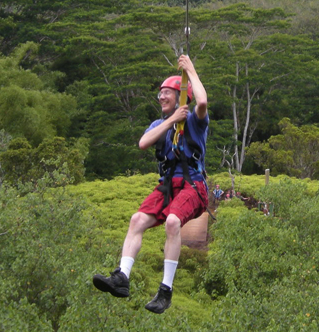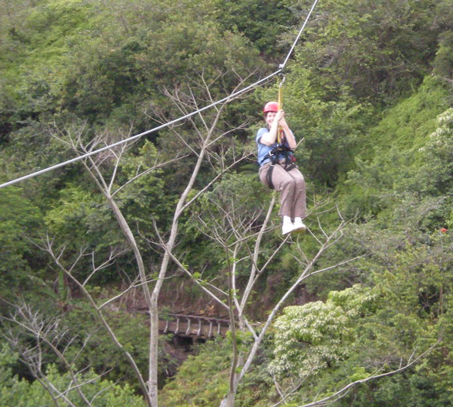I’m back from my sojourn in Hawaii! It was great to get away from everything for a few days … but then I got slammed with things to do and things to worry about when I got back home. Within a day I was telling Kay, “I need another vacation!”
Before I get to some chess news, let me show you some pictures from our trip. If you aren’t interested in anything but chess, you can fast-forward past this part and go to the chess news at the bottom of this post.
Hawaii Trip
One of the most fun things that Kay and I did was to go ziplining. If you haven’t heard of this, the idea is that you get in a harness, and they attach you to a cable that stretches all the way across a valley, and away you go. It’s almost like being a bird — you have complete freedom of motion (although turning upside down is not recommended), you can feel the wind rushing by you, and you are never in any danger of falling.
Here we are before our first ride on the zipline, all psyched up and ready to go:
That’s Mount Waialeale, the rainiest spot on Earth, in the background. The clouds only go away a few times a year, and only for a few minutes at a time.
Here I am demonstrating my rather poor zipline technique:
On one of my rides my arms and legs were all sticking out in different directions, and Kay asked the guide what she would call that posture. She said, “The freaked-out cat.” Kay said, “You mean, like a cat about to be bathed?” After that, they called it the “wet cat,” and everyone wanted to see me do the wet cat again!
Here is Kay, whom the guides praised for having very good, relaxed posture:
We stayed on the island of Kauai, which is very green and moist. It’s called the “Garden Island” for good reason. We toured a couple of botanical gardens, and the hotel also offered a tour of the grounds. Our guide, Brittany, spotted two chameleons on a hala tree. Can you see them?
Of course we also went to a luau, at Smith’s Tropical Paradise. They claim to have the best luau on the island, and we weren’t disappointed. Besides hula dancing, there was Tahitian, Samoan, Maori, Japanese, Filipino, and Chinese dancing, and there was a really spectacular moment when Pele comes out of a simulated volcano and shoots her fire up into the air. Unfortunately I don’t have any pictures, as flash photos were not allowed.
One night we went to a concert by a couple named Doug and Sandy McMaster, who live in Hanalei, and have been giving two concerts every week for ten years. That’s 1042 performances, every one of them different! Doug plays traditional slack-key guitar and Sandy plays ukulele. They warned the audience that if we bought their CD’s, we shouldn’t play them in the car because the music is incredibly relaxing. But if you want to relax and remember what life is like in the slow lane, there’s nothing better.
One thing that Sandy mentioned, just casually, is that there is a cliff alongside Hanalei Bay called Puff. Remember this Peter, Paul and Mary song?
Puff, the magic dragon, lived by the sea/ And frolicked in the autumn mist in a land called Honalee.
Well, Hanalei is “by the sea.” It sure gets a lot of mist (though not just in autumn). And here is Puff, the Magic Dragon himself:
That’s me dancing hula in the bottom left. Above my head is the dragon’s mane. The bare patch above me and to the right is his eye, and sticking out to sea you can see his snout. Once you’ve been clued in, it’s almost impossible to look at the cliff and not see Puff!
If you read the Wikipedia entry on “Puff, the Magic Dragon,” you’ll see that the lyrics were probably written with no knowledge of Hanalei. Nevertheless, the people of Hanalei claim Puff as their own, and I think they have a right to. If I were a magic dragon, and could pick any place in the world to live, I think I’d choose Hanalei, too.
The Kauai–Santa Cruz Connection
I was surprised at how many people on Kauai had lived in Santa Cruz, or passed through Santa Cruz, or knew someone who lived in Santa Cruz, etc. For example, our zipline guide, Azure, was born in Santa Cruz. “Yup,” she said. “I had hippie parents, and I got a color for a name.” They moved out to Kauai when she was five.
Here is my explanation of the Kauai–Santa Cruz connection. Santa Cruz is one of the mellowest places in the country to live. But if you’re too mellow for Santa Cruz, about the only place you can go that’s even mellower is Kauai.
New ChessLecturer
Those of you who subscribe to ChessLecture already know this, but for everyone else it’s news. We have a new lecturer who is a very big name: grandmaster Roman Dzindzichashvili. He’s recorded two lectures already, and I listened to the second one. It’s called “Sound and Unsound Opening Traps, Part I: The Sound.”
This was an extremely interesting lecture to me. I am basically not interested in opening traps. Studying traps is like looking for a short-cut to victory: it’s like saying I can’t be bothered to really understand the game, so I’ll just try to trick my opponent. There are two problems with this approach. (1) It doesn’t work. The opponents will rarely fall into your traps. And even when they do, by then you might have forgotten it. (2) It is disrespectful to the great game of chess.
But Roman’s take was very interesting. He said that there is nothing wrong with playing opening traps, as long as you are playing moves that are in accordance with opening principles and the inner logic of the position. That way, if your opponent doesn’t fall for the trap, you will still have a good game and a plan of action. These are what he calls “sound traps.” The unsound traps, which he will presumably discuss in his next lecture, are the ones where you compromise your position in order to set the trap. These should be avoided.
He gave three excellent examples of sound traps, one in the Two Knights Defense, one in the Grunfeld Defense, and one in the Caro-Kann Defense. I had actually covered the Two Knights trap in one of my lectures on the Two Knights, and it is also a beautiful example of the “Hook and Ladder Trick,” which I discussed in my lecture by that name. It was interesting to me to see how another lecturer, and a grandmaster, would explain the same thing. The only criticism I would make is that he didn’t seem to recognize (or at any rate, he didn’t say) that the Hook and Ladder Trick is a theme that will work in lots of other positions, too.
Most of the listener comments were very positive. However, there were two negative comments. One of them was that Roman didn’t say enough about the other side lines in the openings he considered, and he didn’t address what to do if the opponent doesn’t fall into the trap. I can understand the comment, but I don’t agree with the criticism. It is true that he zips through 10 or 12 moves of the opening with very little comment on why those particular moves are standard. But let’s face it — if he had done that, it would have been a completely different lecture. It would be a lecture on the Two Knights, or on the Grunfeld, etc. He wanted to make a point that was more general than just one specific opening. If he had gone into the side lines, the lecture would have been much longer and would have lost its focus.
Also, the guy is a GM. This lecture is not for babies. He’s not spoon-feeding you: He expects you to do some work, too. So if you want to understand what to do if your opponent doesn’t fall into the trap, then his lecture should inspire you to look it up (or work it out) yourself.
The other criticism, which may be more valid, is that a lot of the material covered in this lecture is also on his DVDs. I certainly hope that Roman will do more on ChessLecture than repeat his DVDs, and if he is going to give one lecture a week, I think he will eventually have to. However, even this criticism didn’t bother me, because I don’t own Roman’s DVDs! So basically I am now getting some highlights from his DVD courses for free! (Assuming I have already paid my ChessLecture subscription.)
For those of you who don’t subscribe to ChessLecture, I think that Roman’s lectures are a great reason to consider subscribing. And just remember, for the same price you also get Sensei Jesse Kraai’s lectures, as well as mine! (Blush, blush, scuff, scuff.)
Cabrillo College Quads
Last but not least, an exciting piece of news for local Santa Cruz chess: tomorrow (Saturday, May 30) Yves Tan is going to direct quads at Cabrillo College. As most of you know, in quads the contestants are broken into groups of four, and you play a round robin within your group. The entry fee is $20 onsite, and the prizes are extremely generous because the college is providing some sponsorship money. So in fact Yves will return more than 100% of the entry fee in prize money. I don’t think I have to explain to you why that is a great deal!
It would be nice if this could become an ongoing series, although I suspect it will be hard to keep up the more-than-100% prize fund on a permanent basis. Back when I lived in Richmond, Virginia (1976-79) and the Triangle area of North Carolina (1983-89), in both places there was a long-running series of monthly or bimonthly quads.
In retrospect, I think those quads were a great thing for my development as a chess player. In quads you are forced to compete with players who are at a comparable level, which makes them very different from Swiss Systems, when you often play five rounds without facing a single opponent within 200 points of your rating. Playing people at your own level really keeps you honest. When you’re always playing people who are much higher or lower than you, there is a tendency either to get lazy (against the lower-rated players) or discouraged (against the higher-rated ones). But when you’re playing people at your level, every game is a battle. As it should be.








{ 2 trackbacks }